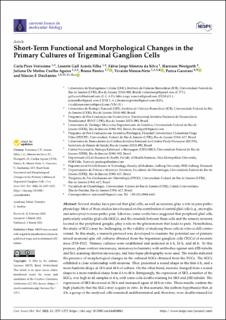| dc.contributor.author | Pires Veríssimo, Carla | |
| dc.contributor.author | Filha, Lionete Gall Acosta | |
| dc.contributor.author | da Silva, Fábio Jorge Moreira | |
| dc.contributor.author | Westgarth, Harrison | |
| dc.contributor.author | Aguia, Juliana De Mattos Coelho | |
| dc.contributor.author | Pontes, Bruno | |
| dc.contributor.author | Moura-Neto, Vivaldo | |
| dc.contributor.author | Gazerani, Parisa | |
| dc.contributor.author | DosSantos, Marcos Fabio | |
| dc.date.accessioned | 2022-07-08T14:03:26Z | |
| dc.date.available | 2022-07-08T14:03:26Z | |
| dc.date.created | 2022-03-03T16:14:27Z | |
| dc.date.issued | 2022-03-08 | |
| dc.identifier.citation | Current Issues in Molecular Biology. 2022, 44 1257-1272. | en_US |
| dc.identifier.issn | 1467-3037 | |
| dc.identifier.issn | 1467-3045 | |
| dc.identifier.uri | https://hdl.handle.net/11250/3003895 | |
| dc.description.abstract | Several studies have proved that glial cells, as well as neurons, play a role in pain patho-physiology. Most of these studies have focused on the contribution of central glial cells (e.g., microglia and astrocytes) to neuropathic pain. Likewise, some works have suggested that peripheral glial cells, particularly satellite glial cells (SGCs), and the crosstalk between these cells and the sensory neurons located in the peripheral ganglia, play a role in the phenomenon that leads to pain. Nonetheless, the study of SGCs may be challenging, as the validity of studying those cells in vitro is still controversial. In this study, a research protocol was developed to examine the potential use of primary mixed neuronal–glia cell cultures obtained from the trigeminal ganglion cells (TGCs) of neonate mice (P10–P12). Primary cultures were established and analyzed at 4 h, 24 h, and 48 h. To this purpose, phase contrast microscopy, immunocytochemistry with antibodies against anti-βIII-tubulin and Sk3, scanning electron microscopy, and time-lapse photography were used. The results indicated the presence of morphological changes in the cultured SGCs obtained from the TGCs. The SGCs exhibited a close relationship with neurons. They presented a round shape in the first 4 h, and a more fusiform shape at 24 h and 48 h of culture. On the other hand, neurons changed from a round shape to a more ramified shape from 4 h to 48 h. Intriguingly, the expression of SK3, a marker of the SGCs, was high in all samples at 4 h, with some cells double-staining for SK3 and βIII-tubulin. The expression of SK3 decreased at 24 h and increased again at 48 h in vitro. These results confirm the high plasticity that the SGCs may acquire in vitro. In this scenario, the authors hypothesize that, at 4 h, a group of the analyzed cells remained undifferentiated and, therefore, were double-stained for SK3 and βIII-tubulin. After 24 h, these cells started to differentiate into SCGs, which was clearer at 48 h in the culture. Mixed neuronal–glial TGC cultures might be implemented as a platform to study the plasticity and crosstalk between primary sensory neurons and SGCs, as well as its implications in the development of chronic orofacial pain. | en_US |
| dc.description.sponsorship | This research was funded by: Fundação Carlos Chagas Filho de Amparo à Pesquisa do Estado do Rio de Janeiro (FAPERJ): JCNE; The APC was funded by Conselho Nacional de Desenvolvimento Científico e Tecnológico (CNPQ): PQ-2. This study is not sponsored by any company. | en_US |
| dc.language.iso | eng | en_US |
| dc.publisher | MDPI | en_US |
| dc.relation.ispartofseries | Current Issues in Molecular Biology;Volume 44 / Issue 3 | |
| dc.relation.uri | https://www.mdpi.com/1467-3045/44/3/84 | |
| dc.rights | Navngivelse 4.0 Internasjonal | * |
| dc.rights.uri | http://creativecommons.org/licenses/by/4.0/deed.no | * |
| dc.subject | Primary cell cultures | en_US |
| dc.subject | Trigeminal ganglia | en_US |
| dc.subject | Neurons | en_US |
| dc.subject | Satellite glial cells | en_US |
| dc.subject | Orofacial pain | en_US |
| dc.title | Short-Term Functional and Morphological Changes in Primary Cultures of Trigeminal Ganglion Cells | en_US |
| dc.type | Peer reviewed | en_US |
| dc.type | Journal article | en_US |
| dc.description.version | publishedVersion | en_US |
| dc.rights.holder | © 2022 by the authors | en_US |
| cristin.ispublished | true | |
| cristin.fulltext | original | |
| cristin.qualitycode | 1 | |
| dc.identifier.doi | https://doi.org/10.3390/cimb44030084 | |
| dc.identifier.cristin | 2007448 | |
| dc.source.journal | Current Issues in Molecular Biology | en_US |
| dc.source.volume | 44 | en_US |
| dc.source.issue | 3 | en_US |
| dc.source.pagenumber | 1257-1272 | en_US |

